THE QATSPY® Yorker Performance Sports Training & Apparel Quarters
INSIDE THE LEATHER HEALTH & FITNESS SPORTS PERFORMANCE
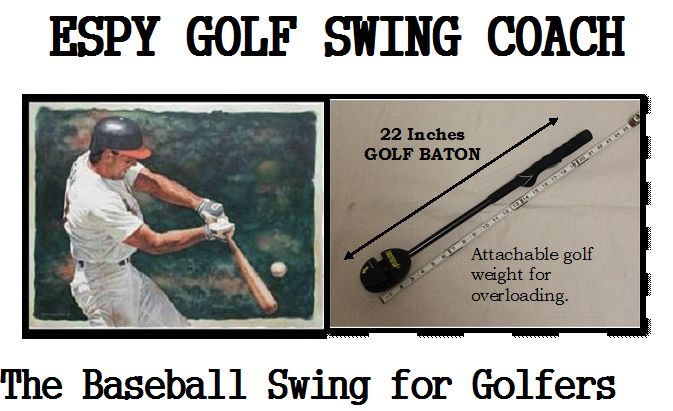
By: Charles W. Boatright
How to Use the Overload/Under-load technique to Improve Your Golf Game
In the past three blogs on the Overload/Under-load golf technique, I have discussed a golf training technique called Overload/Under-loading golf technique. This Overload/Under-load golf technique has been used by baseball players for decades while warming-up in the on deck circle for swing speed and power. This Overload/Under-load golf technique allows the baseball player, or golfer in this case, to increase their swing speed and power.
I have written three previous articles discussing the concepts, benefits, and application of the Overload/Under-load golf technique. in this article, I will summarize these three articles, along with the Critical Swing Path the golfer needs to develop the critical muscle memory, or ExtraSensory Performance, ESP, needed to improve your golf game. In this last article, in a series of four, I will detail the important sequence of The ESPY Golf Swing Coach, based on the baseball-style swing. This allows the golfer to take their baseball-style swing from the batter’s box to the tee box with confidence.
Concept of the Overload/Under-load golf technique
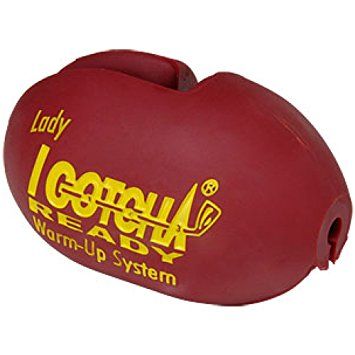
CONCEPT- of Overload/Under-load technique was borrowed from baseball in how baseball players used a specific weight and placement to strengthen the muscles to improve the batter’s bat speed, to increase power, and to improve the On-base Percentages (OBPs). From extensive research done by Dr. Coop DeRenne, it is not just adding weight to the golf club, but the amount of weight and location of the weight.
The weight should not exceed 20 percent of the average golf club (11.72 oz.) and the center of the weight (IGOTCHA®), shown below in the photograph, is placed approximately 50 percent of the length of the club, down from the end of the handle. The weight that the golfer is looking to use is approximately 10 oz. (the weight of the Black IGOTCHA attachment), the cut-off golf baton is 3.89 oz. for a total golf baton overload weight of 13.89 oz. The percentage of overweight factor is 18.5 percent. The IGOTCHA weight can easily be attached and detached from a golf baton (see diagram) in how I use the golf baton as a Overload workout.
Benefits Overload/Under-load golf technique
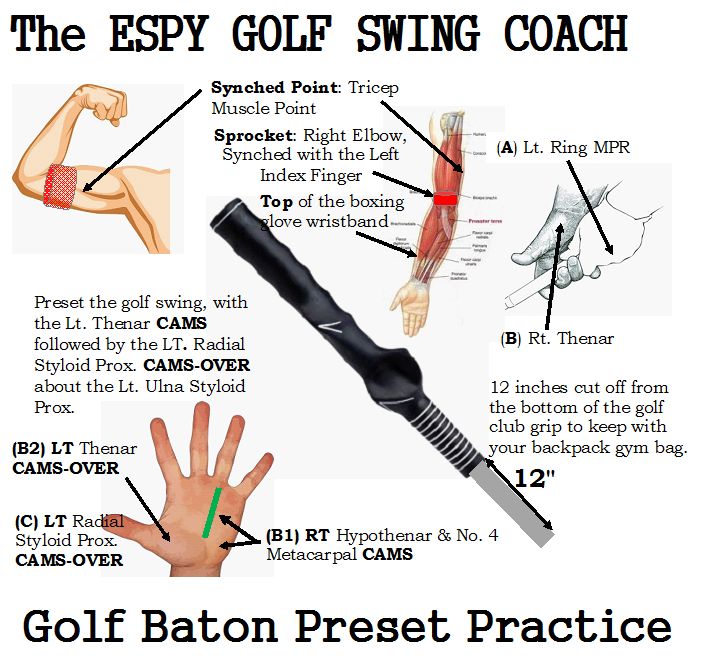
BENEFITS- of Overload/Under-load golf technique help to strengthen the muscles and maintain flexibility, while helping you actually perform the sequential SPY elements in your golf swing practically anywhere. The golf baton is a critical component of the golfer’s incremental training that the golfer can perform 10- minutes out of each hour. The amount of the overloaded weight is critical because heavier weight will change up the golfer’s mechanics and ESP, or muscle memory. It is difficult to establish the correct muscle memory mechanics using heavier weights. Heavier weights will jeopardizes the golfer’s objective of synchronizing the elbows with the shoulders, which is the whole premise of both the golf baton and The ESPY Golf Swing Coach, SYNCING is the key component.
I would highly recommend the golfer include the Overload/Under-load golf technique using a golf baton in home gym workout program along with the CASE Workout Program. The golfer can use the Golf Baton as relief exercises at their office and work on establishing an instinctive golf swing.
As a golfer, one of the best home gym training techniques to incorporate in your workout routine is to strengthening the muscles using the actual golf swing with Overload weight with reps for 10-minutes each hour for 10 to 12 periods. This is just as critical as your golf swing practice. When you set up your Home Training Gym you don’t have to use heavy weights. In my CASPER workout program in Section 20 of my book, the maximum dumbbell weight that I use is 35 pounds. Adding bulk is counterproductive in golf, as the golfer wants to increase flexibility and strengthen for increase clubhead speed.
APPLICATION- of the weighed golf baton
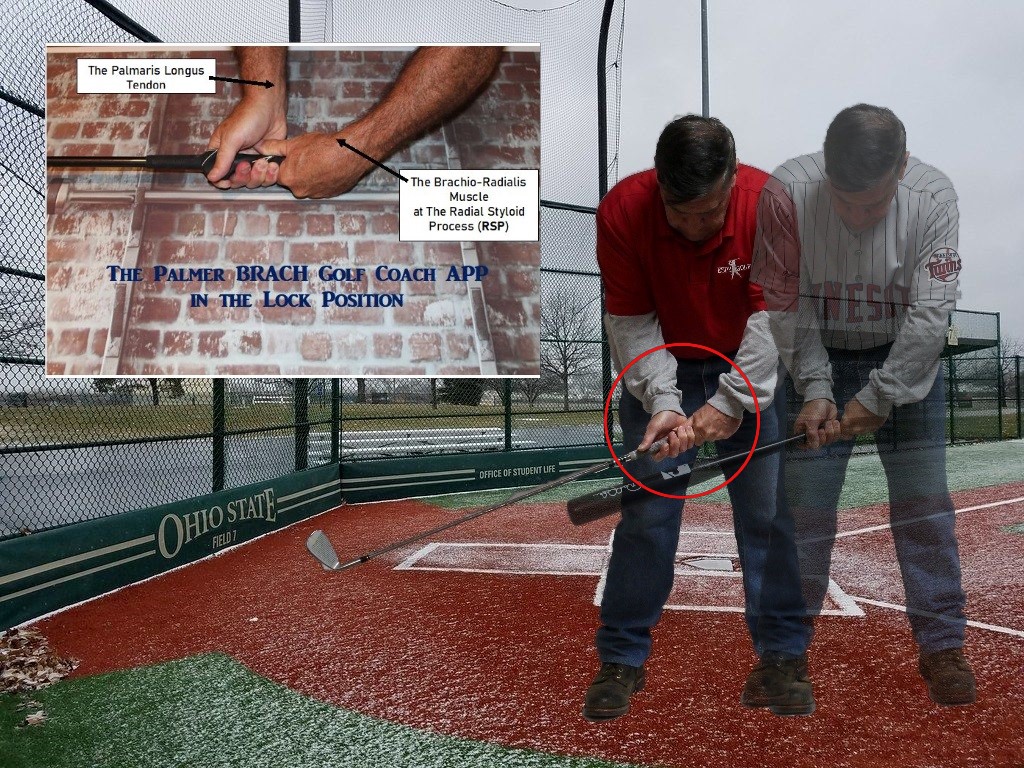
APPLICATION- of the weighed golf baton is a great workout program for the golfer of any level or handicap. The golfer goes through the exact Ergonomic swing sequence of SYNC, PRESET, and YAW sequence, as if the golfer is executing the actual golf swing, either inside or outside. This can be done for 10-minutes, 12 times a day, for 120 minutes, or two hours, per day. This was what Colonel George Robert Hall used during his seven-and-a-half years as a P.O.W. at the Hanoi Hilton.
He was still able shot a 76, his handicap of four, at The Greater New Orleans POW Pro-Am. Who I had an opportunity to meet and interview. This was less than six weeks after his release and his weight being 100 pounds less than the day he was shot down. One of the fundamentals in my book, The ESPY Golf Swing Coach, is establishing three very simple sequential elements, and two of them, SP, are done at the same time to sync the elbows and preset the wrists. This was similar to the procedure used by Colonel Hall during his captivity to keep his sanity and his handicap of four.
Below are by Three Orange Buckets Challenge Explaining, Demonstrating, and Performing Four-in-a-roll 295-yard Tee shots that land within 15- feet of my orange bucket:
THE Orange Bucket Challenge Link INTRO
The Orange Bucket Challenge Walk-Through
The Orange Bucket Challenge Demo
While the golfer uses most of the 640 muscles in the human body to execute a golf swing, the golfer with the ESPY Overload/Under-load golf technique is focused on just using just Two (2) of these 640 muscles. The FIGURE No. 4 Transposing the Baseball swing with the Golf Swing. ‘The Ergo Sync- Preset- Yaw Maneuvers.’ shows the muscles the golfer key in on during the Overload/Under-load golf technique. The Critical Swing Path referring to the muscle sequence starts with setting the Palmaris Longus (or Palmer for short) muscles to sync the right elbow (in the right hander case) and preset the golfer’s wrists using Brachio-Radialis (or BRACHS) muscle the as shown in illustrations above. The Yaw element is initiated using the same Brachio-Radialis muscle. These two muscles makeup the golfer’s Critical Swing Path.
The ESPY Golf Swing Coach is like basic training for these Two muscles. The Palmer is critical to SYNC the golfer’s elbow with their shoulders. The BRACHS is critical to set PRESET Element. These have direct control over your thenars that are the largest and the strongest and most dexterous muscle in the hand that has direct contact with the handle of the club.
The Thenars are really the only muscle strong enough to transfer the power from the lower and upper body through muscle in the forearm, particularly the Palmer and BRACHS muscles. The thenars are the only large muscles that are in direct contact with the handle of the golf club. The ESPY golf swing technique is essentially how the right PALMER muscle is CAMMED (supinated) and left BRACHS muscle is CAMMED-OVER (pronated) for the right handed golfer. This is was the SYNC-PRESET technique that Colonel Hall and Ken Duke, PGA golfer, uses and refers to in their discussions on the golf swing.
Mr. Eddie Merrins produced a series of videos
Mr. Eddie Merrins, The Little Pro, produced a series of videos entitled Swing the Handle, not the club. This video series explained WHAT coaching techniques Mr. Merrins used that the golfer can put into practice in his/her golf swing and during the Overload/Under-load golf technique. My book takes this concept two steps further by coaching the WHY and more importantly the HOW, part of the Triad Learning Pyramid. A great mental image that allows the golfer to use one of the strongest attributes the golfer has, the subconscious mind to create muscle memory.
PALMER, SYNC– Is performed by the right PALMER muscle by CAMMING to synchronize the right elbow with the shoulder, for the right handed golfer called supination.
PRONATE or PRESET– Is performed with the left BRACHS muscle by CAMMING-OVER (called pronation) to Lock the right elbow with the shoulders. This allows the golfer to set up the sprocket mechanics that provides a huge advantage to produce power during the takeaway swing (small gear, right elbow, turning the larger gear, shoulders) and speed during the downswing (Large gear turning the small gear) during the YAW maneuver.
Critical Swing Path using the Overload/Under-load golf technique
Check out my full library of BLOGS @ www.espygolfapp.com/blog or purchase your copy of “The ESPY Golf Swing Coach” @ www.espygolfapp.com/store.
Facebook – The QATSPY Golf Approach
Twitter – @cwboatright
Google+ – ESPY Golf Swing Coach
YouTube – ESPY Golf Swing Coach
Once you learn WHY, you don’t forget HOW!
YouTube Videos:
https://youtu.be/ZGVNrIw_wlo (Cam & Cam-over elements)
https://youtu.be/K2FDHZ3AX9w (Figuring your proper swing plane)
https://youtu.be/TO82PMO6G8M (Developing muscle memory)
https://youtu.be/BWksNM6X8a0 (Baseball-type golf swing)
Please take advantage of my SR-925 Diet Program, where I lost 6 inches in my waist in 3- months (FREE of CHARGE) with the CASPER Workout Program, detailed in Section 20 of my book:

Also, learning The ESPY Golf Swing Coach process is an excellent way to develop Rhythm without experiencing the Blues in your golf game, learn how to take your baseball-style swing from the batter’s box to the tee box: https://goo.gl/olwgxG
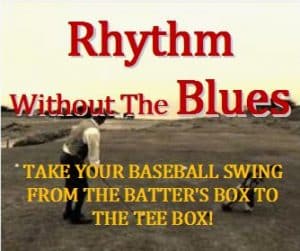
Please visit “The Locker Room” for a Index of all my golf articles to improve your golf game and life. Discover how you can take your baseball swing from the batter’s box to the tee box.

Until next time– Be Synched, Tee-to-Green, with The ESPY Golf Swing!
CONCEPT- of Overload/Under-load technique was borrowed from baseball in how baseball players used a specific weight and placement to strengthen the muscles to improve the batter’s bat speed, to increase power, and to improve the On-base Percentages (OBPs). From extensive research done by Dr. Coop DeRenne, it is not just adding weight to the golf club, but the amount of weight and location of the weight. The weight should not exceed 20 percent of the average golf club (11.72 oz.) and the center of the weight (IGOTCHA®), shown below in the photograph, is placed approximately 50 percent of the length of the club, down from the end of the handle. The weight that the golfer is looking to use is approximately 10 oz. (the weight of the Black IGOTCHA attachment), the cut-off golf baton is 3.89 oz. for a total golf baton overload weight of 13.89 oz. The percentage of overweight factor is 18.5 percent. The IGOTCHA weight can easily be attached and detached from a golf baton (see diagram) in how I use the golf baton as a Overload workout.
